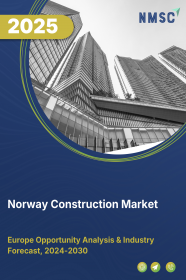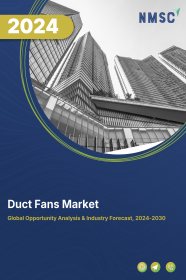
Norway Construction Market by Type (Renovation and New Construction), and by Sector (Real Estate, Infrastructure, and Industrial)–Opportunity Analysis and Industry Forecast, 2024–2030
Industry: Construction & Manufacturing | Publish Date: 25-Mar-2025 | No of Pages: 142 | No. of Tables: 108 | No. of Figures: 53 | Format: PDF | Report Code : CM2207
US Tariff Impact on Norway Construction Market
Trump Tariffs Are Reshaping Global Business
Norway Construction Market Overview
The Norway Construction Market size was valued at USD 65.98 billion in 2023, and is predicted to reach USD 101.70 billion by 2030, at a CAGR of 7.7% from 2024 to 2030.
The construction market, also known as infrastructure, plays a vital role in the economy by overseeing the entire lifecycle of various physical structures, including infrastructure, buildings, and facilities. This industry encompasses a wide array of projects, ranging from residential, commercial, and industrial developments to civil engineering and institutional infrastructure endeavors.
Collaboration among various stakeholders, including architects, engineers, contractors, suppliers, developers, investors, and government agencies, is essential for its operations. Positioned for growth, the industry is being driven by an increased emphasis on environmentally sustainable practices, such as the integration of green building materials and energy-efficient designs. Furthermore, factors such as rising per capita income in emerging economies and low-interest rates in developed nations are expected to further propel the expansion of the infrastructure market.
Rising Investments and Government Support is Driving the Construction Market Growth
The construction market in Norway is experiencing a substantial surge, propelled by increasing investments in infrastructure and supportive measures from the government. Notably, NCC, a prominent infrastructure firm, secured a contract from the Norwegian Public Roads Administration to develop a new road and tunnel in Aalesund Municipality, Norway, valued at approximately USD 0.14 billion in 2024. This significant project reflects a positive trend towards stability and expansion within Norway's infrastructure industry, indicating a promising outlook for sector growth.
Growth of the Construction Industry Boosts the Construction Market Growth
The notable increase in the overall construction market size in Norway is attributed to the remarkable expansion of the infrastructure industry, commands a significant portion of the GDP. According to a report by the United Nations Economic Commission for Europe (UNECE), the infrastructure sector contributed 4.8% to Norway's GDP in 2022, surpassing countries such as the Netherlands, Portugal, and Greece. This substantial contribution of the infrastructure sector to Norway's GDP plays a pivotal role in driving the market's overall growth trajectory.
Regulatory Complexities is a Barrier to Construction Market Growth
In the construction market, overcoming regulatory complexities poses a significant challenge. Infrastructure projects often encounter obstacles due to the intricate web of government regulations and permitting procedures. Infrastructure endeavors demand numerous permits and approvals from governmental bodies at local, regional, and national levels.
These mandates encompass adherence to zoning regulations, environmental assessments, compliance with building codes, safety standards, and various regulatory stipulations. The lengthy process of acquiring permits, bureaucratic inefficiencies, and disparities in regulations among different jurisdictions can substantially prolong project timelines and inflate costs. Furthermore, fluctuations in regulations or unexpected policy changes can disrupt ongoing projects and deter potential investments.
Integration of Digitalization and BIM Presents Lucrative Opportunity for Market Expansion
The construction market is undergoing a transformative phase with the integration of digitalization and the adoption of Building Information Modeling (BIM). By leveraging advanced technologies such as BIM, efficiency, accuracy, and collaboration across diverse projects are enhanced.
BIM, a sophisticated 3D modeling tool, empowers stakeholders to generate and manage digital representations of structures and infrastructure, facilitating improved coordination and communication among project teams. For example, in September 2022, the National Institute of Building Sciences (NIBS) initiated the Norway National Building Information Management (BIM) Program. This program aims to revolutionize the infrastructure sector, achieving unprecedented levels of industrial efficiency through digitalization. By addressing the inadequacy of digitalization within the Norway infrastructure sector, the initiative seeks to streamline lifecycle work processes, making them more efficient, cost-effective, resilient, and safer for infrastructure and maintenance.
Competitive Landscape
The market players operating in the Norway infrastructure industry include Veidekke ASA, NORBYGG AS, Skanska Norway, Morgan AS, The AF Group ASA , HENT AS, Aker Solutions, Norconsult ASA, Aibel, Robertson Nordisk AS , Grette , Seltor Gruppen AS, PNC Norge AS, Skjelnan Housing , Walloe and Nilsen AS and others.
Norway Construction Market Key Segments
By Type
-
Renovation
-
New Construction
By Sector
-
Real Estate
-
Residential
-
Affordable
-
Luxury
-
-
Commercial
-
Retail Buildings
-
Office Buildings
-
Hospitality
-
Healthcare Facilities
-
Educational Institutes
-
Entertainment Ventures
-
-
-
Infrastructure
-
Transportation
-
Airport
-
Port
-
Rail
-
Road
-
-
Water and Wastewater
-
Energy
-
Telecommunication
-
-
Industrial
-
Manufacturing Plant
-
Warehouses
-
Power Plants
-
Oil Refineries
-
Chemical Plants
-
Key players
-
Veidekke ASA
-
NORBYGG AS
-
Skanska Norway
-
Morgan AS
-
The AF Group ASA
-
HENT AS
-
Aker Solutions
-
Norconsult ASA
-
Aibel
-
Robertson Nordisk AS
-
Grette
-
Seltor Gruppen AS
-
PNC Norge AS
-
Skjelnan Housing
-
Walloe and Nilsen AS
REPORT SCOPE AND SEGMENTATION:
|
Parameters |
Details |
|
Market Size in 2023 |
USD 65.98 Billion |
|
Revenue Forecast in 2030 |
USD 101.70 Billion |
|
Growth Rate |
CAGR of 7.7% from 2024 to 2030 |
|
Analysis Period |
2023–2030 |
|
Base Year Considered |
2023 |
|
Forecast Period |
2024–2030 |
|
Market Size Estimation |
Billion (USD) |
|
Growth Factors |
|
|
Companies Profiled |
15 |
|
Market Share |
Available for 10 companies |
|
Customization Scope |
Free customization (equivalent up to 80 working hours of analysts) after purchase. Addition or alteration to country, regional, and segment scope. |
|
Pricing and Purchase Options |
Avail customized purchase options to meet your exact research needs. |

















 Speak to Our Analyst
Speak to Our Analyst

















